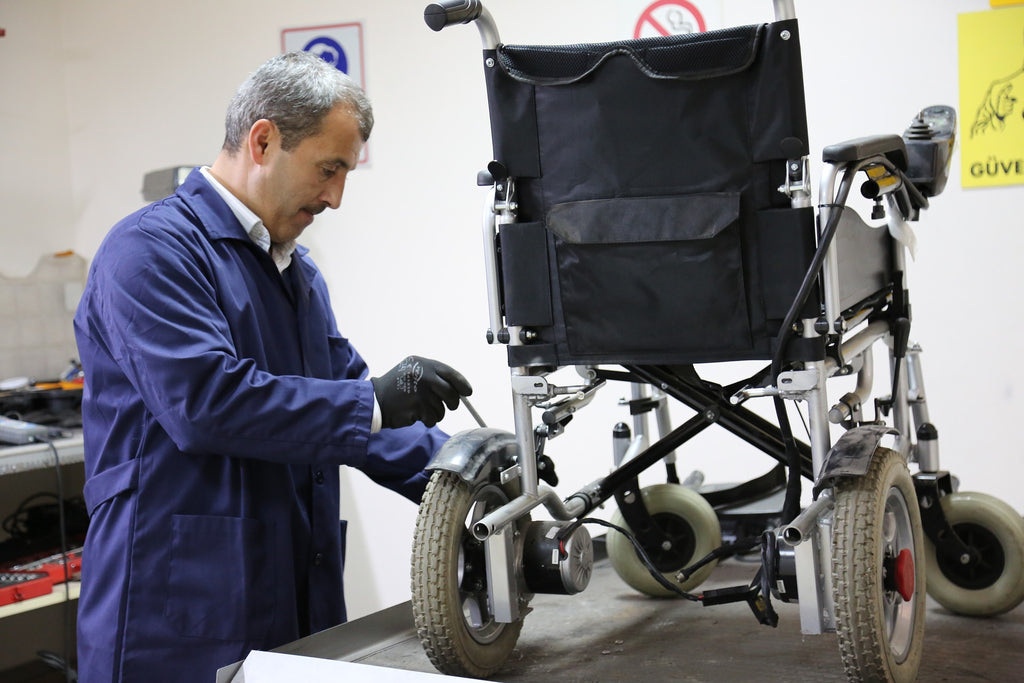Since you rely on the comfort your wheelchair offers daily, it is also as important that you take good care of it. Keeping it well maintained will ensure that you will enjoy the use of it for many more years to come. Here are maintenance tips to keep your electric wheelchair running smoothly.
Following the maintenance tips outlined here will ensure reduction in service costs as well as a possible sidestepping of the inconvenience of waiting for repairs to be completed.
Equally important is to create a daily and weekly routine to keep your wheelchair in top notch condition. While you are at it, ask your family members to help, especially if it is difficult for you to keep a steady balance on your feet while cleaning the chair.
1. Your Toolkit
To simplify matters more and make maintaining your electric wheelchair a breeze, invest in a toolkit or if you have tools at home already, accumulate them to create your own wheelchair toolkit. Once you’ve gathered all the necessary tools and cleaners, keep them together in a zippable bag or a bag that you can easily open and close.
Your electric wheelchair manual might recommend specific tools, but you would also want to make sure that the following tools are included as well:
- An Allen wrench
- A Philips screwdriver
- A flathead screwdriver
- A small cleaner brush
- A bucket for rinse water
- Another bucket for wash water (that’s if you’re not using a spray cleaner)
- A towel
- A few small cloths
- A spray bottle with mild cleaning agent
- An electric wheelchair tire repair kit
Make sure to use an economical but gentle soap. You will find these in most hardware stores. If your electric wheelchair has more stubborn spots, you can use a stronger dilute agent to clean. Please remember to never use an oily cleaner on your electric wheelchair, especially on the tires.
2. Daily Cleaning Your Electric Wheelchair
It is quite important that you wash each bit of the exposed areas of your electric wheelchair daily. You can do so with the spray cleaner or with a bucket filled with warm soapy water after you’ve finished using your electric wheelchair for the day.
Unattended dirt that has built up or food deposits left on the body or in between tiny crevices will cause the mechanisms of your wheelchair to wear out quicker than normal.
Cleaning these areas will not take long if it is done on a daily basis. After washing the chair, go over it again with a damp cloth. Afterwards dry it all off with a dry towel. Make sure that there are no moist areas in the small spaces.
Since you frequently use the controller, dirt and oil from your fingers will build up on it. Wipe it all clean so that dirt does not build up into the electrical and technologically controlling pieces of the electric wheelchair.
3. Maintaining Your Electric Wheelchair Battery
Don’t neglect charging your electric wheelchair battery, even if it has not been in use for a day or for a while. You want to make sure that the wheelchair is properly powered for the next day’s use. Properly caring for your battery that way ensures that your wheelchair battery life is extended.
The United Spinal Association recommends the following about the maintenance of your wheelchair battery:
- Always use the charger that was provided with the wheelchair
- Make sure that the charge level does not drop below 70 percent within the first ten days of using the battery
- Always charge a new electric wheelchair to its capacity
- Make sure that you do not drain your batteries by more than 80 percent.
4. Your Electric Wheelchair Should Remain Dry
You have to make sure that your electric wheelchair is protected from the elements and kept dry at all times because corrosion can take place anytime your wheelchair is exposed to wet weather. Electrical components like the controller and the wire well should especially be kept dry.
Although we might try our best to keep electric wheelchairs out of the rain or snow, sometimes it is inevitable. In the event that you need to use your electric wheelchair while it is raining or snowing outside, it is recommended that you wrap the power control panel with a clear plastic bag.
5. Maintaining Your Tires

Tires should always be kept inflated at the pressure level stamped on the tire. If not stamped on the tire, look for the pressure levels in the operating manual. Under inflating or over inflating your tires can cause serious wobbling of your wheelchair.
What is worse is that the wheelchair can lose direction and veer off to one side. Another side effect is that the tires can wear off unevenly and will most definitely not last long. Tubeless tires are also quite popular in various models.
Where the normal tire has an inner tube, tubeless tires use a sealant which coats the inside of the tire wall to prevent flats. When you run on tubeless tires, you must ensure that your pressure levels are proper at all times.
If your tire pressure is too low, it can cause pinch flats, which is a condition where there is a pinch between the tire wall and the rim of the wheel.
Your wheelchair's wheels and tires contribute to its general smooth operation. Here's how to keep them in top condition:
- Check Tire Pressure: Ensure tires are properly inflated, which is typically noted on the sidewall of the tire.
- Inspect for Damage: Regularly check for punctures, tears, or other signs of wear that may affect safety and performance.
- Clean Away Debris: Keep wheels free from debris and grime, as built-up dirt can affect traction and maneuverability.
6. Your Weekly Maintenance Schedule
Here is a sample of a weekly maintenance routine you can follow or add to your own cleaning routine:
- Try to eliminate all sharp edges as they can be dangerous. Sit on the electric wheelchair and run your hands over all the parts. Try to identify all tears or any sharp edges. If found, eliminate them right away. If the problem is too difficult for you, take it in to a professional for repairs.
- Make sure the backrest and seat feel secure and there are no loose parts which can cause unnecessary falls or serious injury. If needed, tighten loose bolts all around the chair.
- Look at the footwells while seated in the chair. Are your feet well supported? If not, make the necessary adjustments.
- Walk around the wheelchair and check for loose wires. If there are loose wires, look in your manual and determine where these wires belong and reposition them to their rightful place or tie them down with zip ties.
- Check the motor for odd sounds. If you detect any sounds that are off, look into the manual to see if there is any maintenance you can carry out on your own. If you cannot fix it by yourself, contact a repair shop.
7. The Wheelchair Manual
The wheelchair manual is an important piece of your electric wheelchair. Get familiar with the content inside the manual in order to understand its features and its maintenance information, as well as be informed about its safety suggestions.
Manuals normally have important phone numbers of the manufacturer or of approved maintenance personnel. When done reading through your manual, file it somewhere safe or keep it together with your cleaning kit.
8. Battery Care: Prolonging Battery Life
The battery is the heart of your electric wheelchair. To maintain it:
- Charge Regularly: Aim to charge the battery after each use, or when it gets below 50% charge. Avoid deep discharges as they can be damaging.
- Use Correct Charger: Always use the charger provided or one specifically recommended for your wheelchair's battery type.
- Check Water Levels: For lead-acid batteries, check water levels monthly and refill with distilled water as needed.
- Keep Clean: Wipe the battery down with a damp cloth—dirt can drain power and potentially lead to short circuits.
9. Motor and Brake Inspection
The motor and brakes of an electric wheelchair are pivotal to safety and mobility. Inspect and maintain them by:
- Testing Motor Performance: Regularly test motor performance by assessing speed and responsiveness on different terrains.
- Checking Brake Responsiveness: Make sure brakes engage and release properly. Adjust the brakes as needed for optimal performance.
- Avoid Overloading: Don’t carry more than the weight limit specified for your wheelchair, as it can strain the motor and brakes.
- Maintain Drive Tires: Inspect the drive tires for wear and replace them if they're showing signs of balding or significant wear.
10. Frame and Seat Maintenance
The frame and seating structure of your wheelchair play a role in both comfort and safety.
- Tighten Loose Bolts: Periodically check for loose bolts and tighten them to ensure the integrity of the frame.
- Lubricate Moving Parts: Apply a silicone or Teflon-based lubricant to moving parts to prevent squeaking and to keep them operating smoothly.
- Seat Upholstery: Clean the seat regularly, and inspect for any tears or damage, addressing them immediately to prevent further issues.
11. Storage and Handling
How you store and handle your electric wheelchair can significantly impact its longevity.
- Store Indoors When Not in Use: Keep your chair in a dry, climate-controlled environment to prevent damage from the elements.
- Use Protective Covers: When storing or transporting your wheelchair, use protective covers to shield it from dust and moisture.
- Handle With Care: Be gentle when moving your wheelchair, especially when disassembling it for transport. Rough handling can lead to loosened components.
Frequently Asked Questions
Caring for your electric wheelchair is crucial for its longevity and performance. Below, we’ve compiled answers to some of the most commonly asked questions by users like you. These insights aim to enhance your user experience and save you time in getting support.
- How often should I charge my electric wheelchair? Ideally, you should charge your electric wheelchair’s battery daily, especially after significant use. Charging overnight ensures your wheelchair is ready to go when you are, without overcharging the battery.
- What are the signs that my wheelchair needs maintenance? Look out for reduced battery life, unusual noises, difficulties in maneuvering, or any part of the wheelchair becoming loose or uncomfortable. These signs could indicate that your wheelchair requires professional attention.
- Can I clean my electric wheelchair, and if so, how? Yes, cleaning your electric wheelchair regularly is recommended. Use a damp cloth to wipe down the surfaces and mild soap for any stains. Ensure that no water gets into electrical components. Always disconnect the wheelchair from its power source before cleaning.
- How do I store my electric wheelchair when not in use? Store your wheelchair in a dry, cool place away from direct sunlight. If not using it for an extended period, make sure to charge the battery fully, and if possible, disconnect it.
- What should I do if my wheelchair is making unusual noises? Unusual noises often indicate a mechanical issue. Inspect your wheelchair for any visible issues like loose parts or debris stuck in the wheels. If the problem persists, contact a professional repair service.
- Are there any accessories that can enhance my wheelchair's performance or comfort? Absolutely. Accessories such as cushioned armrests, seat covers for extra comfort, or specialized wheels for different terrains can significantly enhance your experience. Look for accessories that suit your lifestyle and wheelchair model.
- How can I extend the battery life of my electric wheelchair? To extend your wheelchair’s battery life, avoid depleting the battery completely, charge it regularly, and store it properly when not in use. Also, keep your wheelchair and its moving parts clean to ensure it operates efficiently.
- What are the common maintenance tasks I can perform on my own? Basic maintenance tasks include tightening any loose bolts, cleaning the wheelchair, and inspecting tires for wear and tear. Regularly check the battery’s performance and connections as well.
- How do I know when it’s time to replace the batteries in my electric wheelchair? Battery replacement is typically necessary when you notice a significant decrease in the distance you can travel on a full charge compared to when the battery was new. If charging doesn’t improve the situation, it might be time for a replacement.
- Where can I find authorized service centers? Typically, the best place to find authorized service centers is through the manufacturer’s website or customer service line. They can provide you with locations and contact details for certified technicians who specialize in your specific wheelchair model.
Conclusion
We hope you liked our article on maintenance tips to keep your electric wheelchair running smoothly, and that it was helpful. Please let us know if you have any questions or if you would like to see more of these types of articles to our site.
We also have a special offer you can benefit from by taking 6% of your order. Simply enter coupon code EW6 at checkout and it will apply the discount. This offer won't be around long, so act soon! See product pages for details and if you have any questions feel free to give us a call at 800-682-9444 and one of our agents will be happy to assist you. We are open every day from 8AM - 8PM est!
If you are more interested in looking for other maintenance related articles or for mobility scooters that fold, our staff compiled a great list of the Top Folding Mobility Scooters of 2020 and have had some great feedback on that article as well. We also have another article on the Top 5 Mobility Scooter Issues And How to Fix Them.
Feel free to write me anytime at kellon@electricwheelchairsusa.com if you have any questions or comments. At Electric Wheelchairs USA, we truly love helping our customers make the best choice for their needs whether it is a power chair, mobility scooter, or lift chair.







